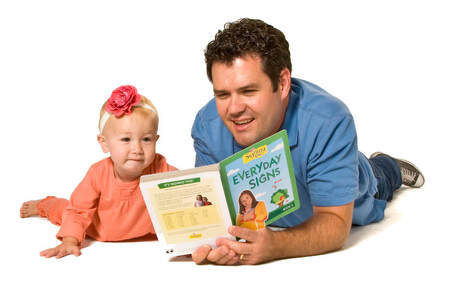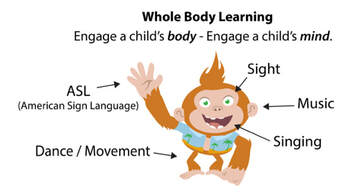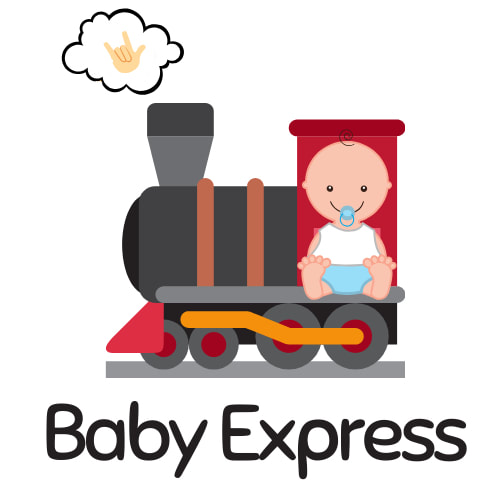Benefits of Signing with Your Baby

What does it mean to sign with your baby? Before they can talk, babies communicate through facial expressions, body language, and gestures. Signing with your baby taps into babies’ natural ability to communicate with their bodies by introducing you and your family to American Sign Language (ASL). Signing is a powerful communication tool for preverbal babies – and an amazing learning tool for toddlers and preschoolers.
When you teach your baby to sign, the benefits are almost immediate.
Babies who sign:
When you teach your baby to sign, the benefits are almost immediate.
Babies who sign:
- are less frustrated because they have a way to communicate.
- feel more confident and secure because their needs are being met.
- can get help immediately because they tell their parents when they are feeling sick or hurt.
Signing also benefits children who are already talking. When signs and words are used together, auditory learners hear the word, visual learners see the sign and kinesthetic learners can use their hands to make the sign. Toddlers and preschool children who sign:
- develop larger vocabularies.
- develop more positive attitudes toward books and reading.
- can potentially experience a long-term boost in IQ. (Linda Acredolo and Susan Goodwyn, “The long-term impact of symbolic gesturing during infancy on IQ at age 8.” Paper presented at the meetings of the International Society for Infant Studies, Brighton, UK. (2000)).In other words, signing creates the perfect storm that can trigger a surge in language learning and cognitive development.
Getting Started Signing with Your ChildSigning with your child is easy and fun – and you can do it every day. You can start from birth. The sooner you get into the habit of signing, the sooner your child can start learning and benefiting from signs. Babies can understand signs at a very early age, but won’t be able to sign back to you until their hands are ready, somewhere between 6 and 12 months of age. Every baby’s developmental timetable is unique. If your baby isn’t signing by 12 months, don’t worry. Some babies don’t start signing back until 13 or 14 months – or even later! A later start to signing isn’t usually an indicator of a language delay; however, if you have a concern, talk it over with your child’s pediatrician.
|
BASIC STEPS TO SIGNING
1. Make eye contact with your child.
2. Use the sign and the word together.
3. Repeat! Look for natural opportunities to use the sign throughout the day.
HOW TO GET STARTED
● Start with a few signs like MILK, MORE, and ALL DONE. Once you get into the habit of using these signs, learn a few more signs, or combine signs to make short sentences such as “MORE MILK?”
● Look for understanding. Babies will recognize your signs before they can sign back to you. Babies may smile, kick their feet, or look in the direction of the object you are signing about to show you they understand.
● Wait for it! Babies 6 to 9 months of age may take two months or more to make their first sign. Older babies may sign back sooner, especially if they see the sign often.
● Praise any attempt your child makes – even if the sign isn’t perfect. Her physical coordination will improve as she grows. For now, just show her how happy you are that she is communicating with you!
1. Make eye contact with your child.
2. Use the sign and the word together.
3. Repeat! Look for natural opportunities to use the sign throughout the day.
HOW TO GET STARTED
● Start with a few signs like MILK, MORE, and ALL DONE. Once you get into the habit of using these signs, learn a few more signs, or combine signs to make short sentences such as “MORE MILK?”
● Look for understanding. Babies will recognize your signs before they can sign back to you. Babies may smile, kick their feet, or look in the direction of the object you are signing about to show you they understand.
● Wait for it! Babies 6 to 9 months of age may take two months or more to make their first sign. Older babies may sign back sooner, especially if they see the sign often.
● Praise any attempt your child makes – even if the sign isn’t perfect. Her physical coordination will improve as she grows. For now, just show her how happy you are that she is communicating with you!
About Whole Body Learning Your baby was born ready to learn. Between birth and 36 months, your child’s brain is growing faster than at any other time. This means that what you do right now really matters. To help you take advantage of this window of opportunity, Whole Body Learning is a fun and effective approach to learning that will nurture your child’s growing mind.
|
Whole Body Learning experiences:
- tap into the power of the five senses to help children make sense of the world and move from simply gathering sensory information to becoming active, creative, problem-solving thinkers. In other words, it challenges young children to develop their creative intelligence.
- are one-on-one to enhance bonding, communication, and learning. With one-on-one activities, you can follow your child’s lead. For example, suppose you are reading a storybook, and your child points to a tree on the page and gets really excited. You can follow your child’s lead by teaching your child the sign for tree, going outside to see the apple tree in your yard, and picking some apples to eat. You may not have finished reading that storybook, but you gave your child the opportunity to gain new knowledge – and a sense of empowerment about directing his own learning.
- fit your child’s natural way of learning. Multisensory learning activities address the needs of all children – no matter what their learning style: visual, auditory, spatial, or kinesthetic.
- are effective because they are playful, fun, and engaging - never forceful, overbearing, or rushed. It is more important to instill a life-long love of learning and build a strong relationship than it is to pressure your child to achieve.
Material on this page excerpted from Baby Signing Time Parent Guide
Enjoy a baby sign language class in Beaverton, OR. Register now to have fun learning ASL vocabulary in a lively Mommy and Me class today! Contact us if you would like more information on how to start signing with your baby, signing with a toddler or signing with children with special needs.
NOTE: When we talk about "baby sign language" or "baby sign", we are referring to incorporating vocabulary from American Sign Language into your daily routines with your baby. We do not make up signs or create special baby signs to use with your little one. In much the same way that parents naturally simplify their word choices and alter the grammatical structure and voice tone of English when talking to their babies, signing with your baby uses simple ASL vocabulary words without the grammar and other nuances that would be necessary to learn American Sign Language. Just like a baby learns English first with sounds and then words, phrases and sentences, signing with your baby gives them the vocabulary needed to communicate with word signs and phrases. As your child gets older and begins to speak as well as sign, we hope that you will continue to use signs with your little one. This could lead to an interest in ASL and provide a foundation for actually learning American Sign Language from a fluent member of the Deaf community. Signing with your baby is a wonderful way to enhance their communication at a young age and then open the door to becoming bilingual with ASL instruction when they are older!


